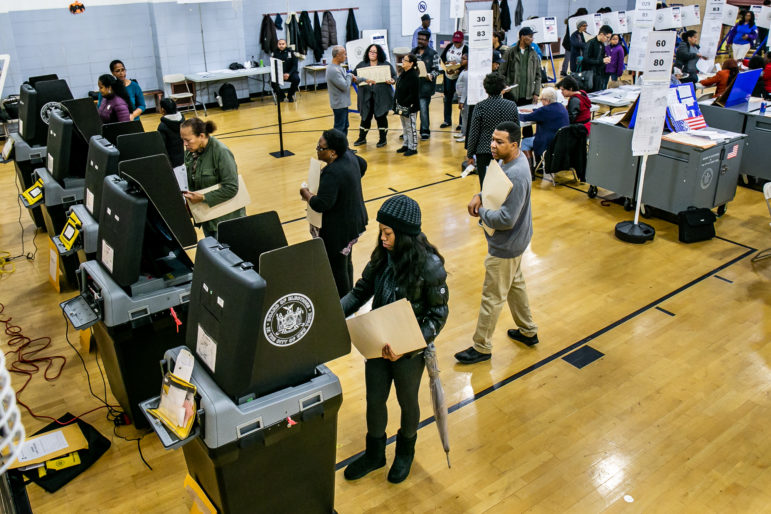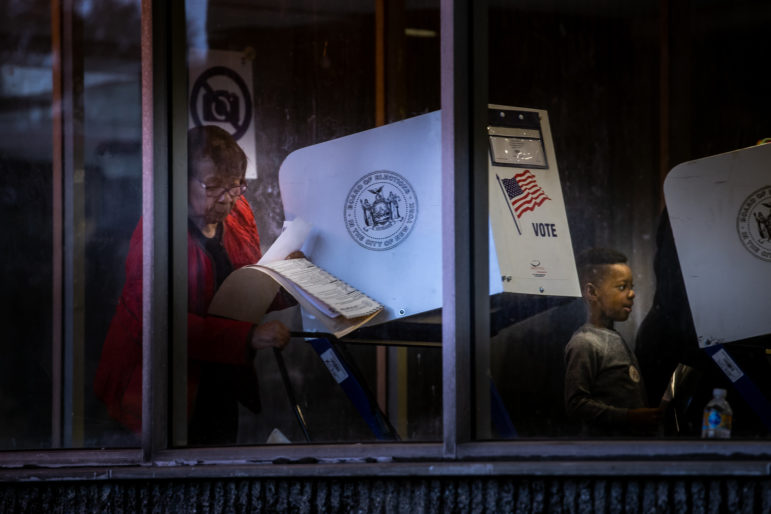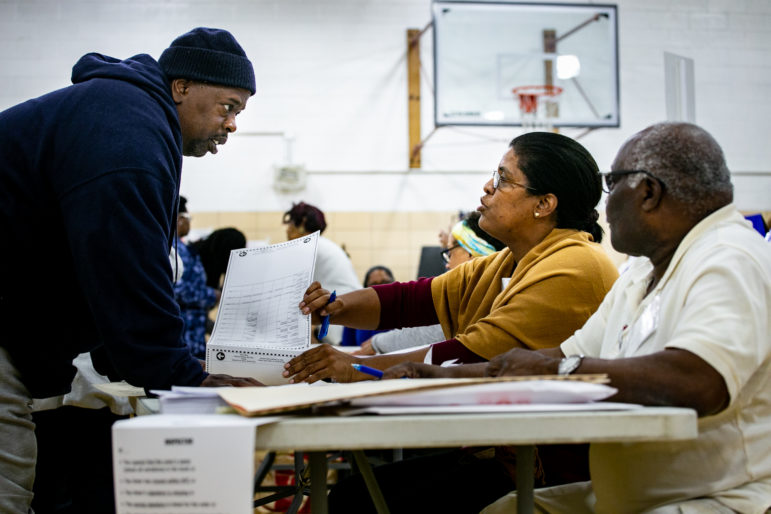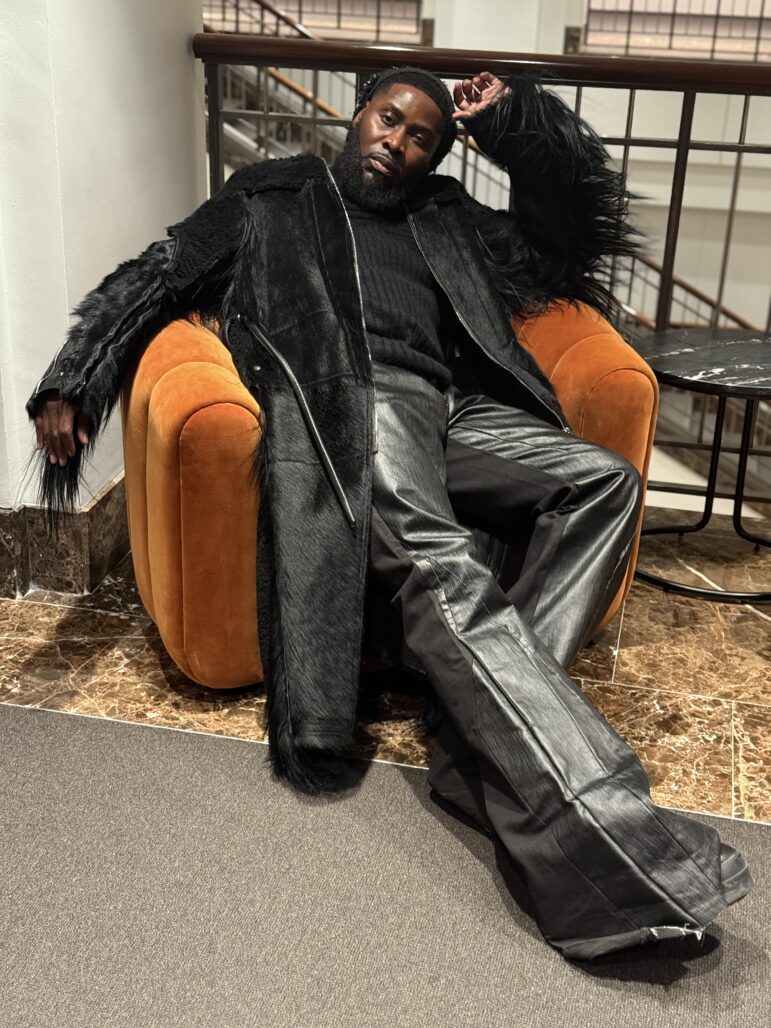
Adi Talwar
Inside the polling Station located in PS41 on Olinville Avenue in the Bronx.
With reporting by Megan Conn, Hailey Lynn Del Valle, Jazmin Goodwin, Arufa Hossain, Sadef Ali Kully, Hannah Miller, Shantal Riley and Michael Tashji
Democrats achieved dominant control in New York State on Tuesday, sweeping statewide offices and seizing control of the State Senate by a comfortable margin.
On a night of mixed results for the two major parties nationwide, New York stood as a pillar of Democratic sentiment, and the party will face high expectations to deliver on the changes promised to voters—although their margin of victory seemed driven as much by dislike for Donald Trump as it was by Democratic pitch to voters.
In voting statewide, Gov. Andrew Cuomo solidified his place as the center of political gravity in the Empire State by winning a third term with a 58 percent to 36 percent victory over Marc Molinaro, the Republican Dutchess Country Executive.
Republicans currently control the State Senate by a 32-31 margin because Democrat Simcha Felder caucuses with them. But Tuesday’s results rendered Felder’s machinations meaningless as Republicans appeared to lose as many as eight seats in the upper chamber of the legislature.
On Long Island, Democrat Monica Martinez beat Republican Dean Murray for the seat being vacated by Republican Tom Croci, Democrat James Gaughran beat incumbent Republican Carl Marcelino, Democrat Kevin Thomas appeared to edge incumbent Republican Kemp Hannon, and Democrat Anna Kaplan defeated Elaine Phillips. Upstate, Democrat James Skoufis defeated Republican Tom Basile in the seat that has been held by the retiring William Larkin, incumbent Republican Terrence Murphy lost to Democrat Peter Harkham and Democrat Jen Metzger prevailed over Republican Ann Rabbitt in the district represented by the retiring John Bonacic.
In the city, Democrat Andrew Gounardes was leading Republican Sen. Marty Golden, who initially refused to concede.
Letitia James, who 15 years ago defied Democratic power brokers to win a special election to the City Council, rode support from the party establishment to an historic win, defeating Republican attorney Keith Wofford in the race for attorney general to become the first woman of color to hold statewide office in New York. James’ victory, with 60 percent of the vote, will create a vacancy in the office of New York City public advocate and necessitate a special election in which a number of rising political stars are expected to participate.
In a local race that mirrored the national story of strong Democratic gains in the House, healthcare executive and Army veteran Max Rose bested incumbent Republican Daniel Donovan in the 11th Congressional district covering Staten Island and a sliver of southern Brooklyn, with Rose claiming a 10,000-vote margin.
It was one of three House seats that appeared to flip red-to-blue in New York State, with Democrat Anthony Brindisi narrowly defeating incumbent Rep. Claudia Tenney in central New York and Antonio Delgado winning over incumbent Rep. John Faso in the Hudson Valley. Indicted Republican Chris Collins and fellow incumbents Lee Zeldin, Pete King, Elise Stefanik and John Katko hung on despite spirited challenges. Democrats now hold 21 of the 27 seats in the state’s Congressional delegation.
Political newcomers Alexandria Ocasio-Cortez, who stunned incumbent Rep. Joe Crowley in the June federal primary for a Bronx-Queens Congressional seat; Alessandra Biaggi, who soundly defeated powerbroker Sen. Jeff Klein in a September Democratic contest; and Julia Salazar, who won in September over veteran Sen. Martin Dilan despite serious questions about the veracity of her biography, all won easily. Salazar faced no general-election opponent.
In a victory for Mayor de Blasio, all three of the ballot questions proposed by his charter revision commission won adoption, the least popular one (question 2, which called for creating a civic engagement commission and a citywide participatory budgeting mechanism) carrying percent of the vote.
Problems with scanning devices at several city polling sites combined with strong turnout led to long lines and lengthy delays and prompted new calls for reform of local voting procedures, and perhaps house-cleaning of the Board of Elections that oversees them.
Parties face different challenges

Adi Talwar
Morning voting at the Tracey Towers Polling station located near Mosholu Parkway in the Bronx.
In other statewide races, Sen. Kirsten Gillibrand cruised against Republican Chele Chiavacci Farley by a 64-33 margin. Democratic comptroller Thomas DiNapoli won a third full term with a 64-30 win over Jonathan Trichter.
Cuomo’s and Gillibrand’s commanding victories will do little to cool the speculation about their viability as presidential candidates. For state Republicans, however the loss of the State Senate for only the second time in half a century and the surrender of three House seats on a night when Democrats maintained hold on the Assembly and all four statewide offices on the ballot represented a nadir. State GOP chairman Ed Cox pointed to the gain of a few Assembly seats as a positive, and noted that it’s not uncommon for the president’s party to lose ground in midterm voting.
“We have much work ahead, and we are as committed as ever to our principles and holding our state’s leaders accountable,” Cox said in a statement. “Tomorrow the fight to save our state continues. “
But Bronx Republican J.C. Polanco, a former member of the city Board of Elections and a candidate for public advocate in 2017, was much more critical of his party in an appearance on the Max & Murphy election night special on WBAI:
While justified in their jubilation, Democrats, however, have a problem of their own: Their commanding victory means they are under intense pressure to deliver on promises of criminal justice reform, shoring up the MTA, protecting reproductive rights, strengthening rent regulations and more. There will inevitably be intra-party tension over how ambitious the agenda should be, with single-payer health care a potentially divisive issue.
Jumaane Williams, the Brooklyn City Councilmember who ran unsuccessfully for the Democratic nomination for lieutenant governor and is now a candidate for public advocate, said in his election night appearance on Max & Murphy that Democrats must deliver:
Turnout and Trump
The 5.8 million votes cast in the gubernatorial race indicated a turnout of just over 50 percent, the highest in at least 20 years. Cuomo earned a higher percentage of votes than he did in 2014 and a higher total number of ballots than in either of his previous elections. While outspent by a large margin and defeated soundly, Molinaro won half a million votes more than Cuomo’s 2014 opponent, Rob Astorino.
At PS 49 in Middle Village, Queens, poll worker Cesar Escalante described the crowds colorfully.
“There’s been a shit ton of people,” he said in the morning. “It’s only 10 o’clock and there are probably 70 to 80 people here voting right now.”
Many voters made clear that national issues drove them to the polls. Carletha Williams, 54, of Jamaica, Queens, said her vote was all about Donald Trump. “Most of his speeches are negative, in some points racially charged,” she explained. “I just don’t like the man. When he comes up on TV, I just turn it off.”
“I hate to say it but local politics is not what drove me to vote today,” said Jan Koehler, who had lived in Staten Island since 1970s. “I do not pretend to know much about economics, I don’t pretend to know much about trade, I don’t pretend to know any of the important stuff in politics. But I do know hate speech when I hear it.”
Maria Herrera didn’t want to wait in line, so she arrived when the polls opened, and was one of the first to cast a ballot at PS 63 Author’s Academy in the Morrisania section of the Bronx. For her, the biggest stake in the midterm elections was women’s rights.
“Women have just as much right to make their own decisions with what they want to do with their bodies, where they stand in the workplace, and to be treated equally. If they’re going to do the same job as a man, they should be compensated as much as a man,” said Herrera.
The first time she voted was 10 years ago, for President Obama, at the age of 18. “It feels exhilarating because this is such an important election. I feel like if I didn’t come out today, who knows where this ballot could have gone,” she said.
Health care was a top concern for some Bronx seniors on Election Day. “We need more health care,” said Co-op City senior Joan Washington. “We need Medicare. A lot of seniors don’t have enough.”
Washington, recovering from a recent surgery, said she was worried about possible cuts to Medicare and Social Security, which face an uncertain future under the Trump Administration.
“It’s not enough right now,” Washington said after voting at the Harry and Jeanette Weinberg Council Towers. “How are we supposed to survive?”
Turnout and trouble
Across the city, many voting sites reported jammed machines and long lines.
Voting in Wakefield in the Bronx got off to a rough start after paper jams caused seven out of eight scanner machines to stop working. The voting poll site went into emergency ballot mode, resulting in voters having to slide their ballots into the polling machines instead of scanning.
“Even though we have an emergency process when the machines are down, most people refuse to use it because they believe their ballots would be stolen or not counted,” said site coordinator Stephen F. Williams.
The scanner breakdowns were caused by paper jams after a new introduction of 19-inch multiple-side ballots. With these new ballots, voters had to tear their ballots in half and push each sheet separately into the scanner machines.
“The idea of the multiple-side ballot is foreign to the Bronx community, most of the voters here are used to one process. They have an issue marking all four sides but separating the ballot themselves caused an inordinate amount of paper jams with the scanner, long lines, a great deal of discontent and conspiracy theories,” said Williams.
Similar scanner issues in other areas of the Bronx caused delays in getting technician assistance to the site right away.
“I can’t call a technician up here when there are fifty and sixty other polls jammed,” said Williams.
Long lines and a crowded space followed as site coordinators waited for technicians to arrive.
At 1 p.m., two out of the six ballot scanning machines were out of commission at PS 8 in Bedford Park, Bronx. Though lines weren’t long, poll workers said they were concerned that more machines would break and that fixes by technicians were only temporary.
A voting site on City Island was left with one voting machine About 200 people crowded into the small gymnasium at Public School 175 to cast their ballots a couple of hours before the polls closed on Tuesday night. People stood waiting in scattered lines. Babies cried and small children ran amuck across the gym floor. It was the only polling site on City Island. A poll worker said crowding was so bad that afternoon people were leaving their ballots on tables and walking away. At one point, a police officer from the 45th Precinct helped poll workers to place the ballots in a bag, she said.
Voters and poll workers at the Plaza Rehab and Nursing Center in Kingsbridge had it easy compared to their counterparts at other sites in the Bronx. When one of their three scanner machines had a paper jam this morning, a technician was on site to fix it within 15 minutes. But poll worker Sharee Melton said the site could use more than the one Spanish interpreter assigned to the site. “People that came in, if they could speak a little English, then we were able to help them out,” she said. “Luckily we have some other people who are fluent in Spanish, so we’ve been getting by.”
Maria Vasquez was one of those poll workers who pitched in to assist Spanish-speaking voters, but she said the language barrier wasn’t necessarily the main source of confusion for voters. “People are getting mixed up with the second ballot page,” she said, “We have to keep explaining.”
The unreliable machines weren’t the only complaint on Election Day. The New York Civil Liberties Union and American Civil Liberties Union filed a lawsuit Tuesday challenging New York’s 25-day voter registration cutoff “for arbitrarily disenfranchising tens of thousands of eligible voters,” according to a statement.

Adi Talwar
A voter with a question at the polling station on Olinville Avenue in the Bronx.








